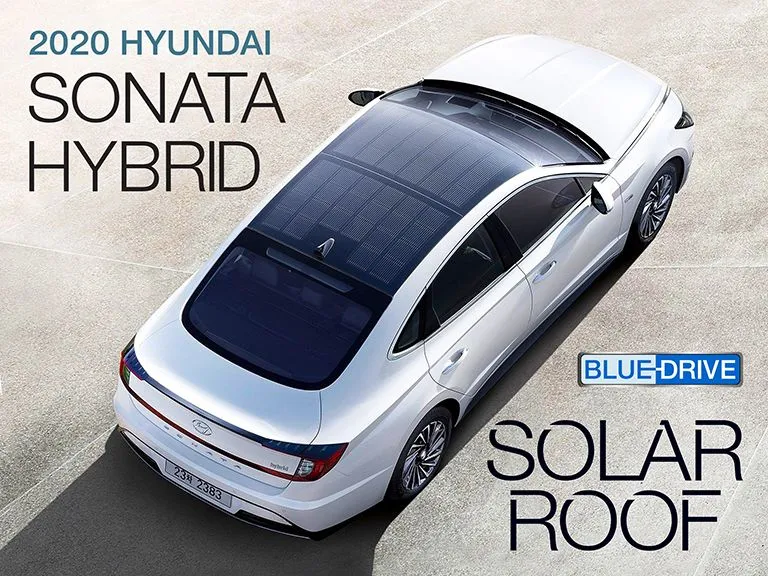
2020 Sonata Hybrid's solar roof will provide 800 extra miles per year
A new Solar Roof technology created by the Hyundai and Kia sister brands will appear on a number of models in the coming years. The first vehicle to receive it is the 2020 Hyundai Sonata Hybrid, now on sale in Korea, soon to appear in the Unites States market.
By John Coulter, Current EV CMO
The charge generated by this first-generation system is minimal; the Sonata Hybrid’s 1.76kWh battery can pull a 30% to 60% charge from the solar roof over and prevent unnecessary battery discharge. Hyundai says this amount represents an additional 1,300 km 808 miles of driving range a year, provided the car charges for 6 hours a day in unrestricted sunlight. The solar cells are transparent and can be embedded in a glass roof.
Heui Won Yang, Senior VP and head of the Hyundai Motor Group Body Technology Unit says, “Solar roof technology is a good example of how Hyundai Motor is moving towards becoming a clean mobility provider. The technology allows our customers to actively tackle the emissions issue. We are striving to further expand the application of the technology beyond our eco-friendly vehicle line up to vehicles with an internal combustion engine.”
Panels located on the roof – and possibly on other surfaces in the future – will charge the batteries of Hyundai internal-combustion, hybrid and pure-electric cars. While plugging in will still be the primary method of charging, the solar panels will serve as a support to the main power source.
Jeong-Gil Park, Executive VP of the Engineering and Design Division of Hyundai Motor Group says, “In the future, we expect to see many different types of electricity-generating technologies integrated into our vehicles. The solar roof is the first of these technologies, and will mean that automobiles no longer passively consume energy, but will begin to produce it actively. It is an exciting development for us, designing a technology for vehicle owners to help them shift from being energy users to being energy producers.”
Hyundai says the second-generation of the new solar roof panel technology they’ve developed will be integrated into the panoramic sunroofs of its future internal combustion cars – a way for the company to meet increasingly stricter CO2 emissions regulations, and a good selling point for cost-conscious and eco-friendly drivers. Hyundai is testing a third-generation system which will boost the energy output of its pure electric vehicles and be integrated in car roofs and “bonnets” – an approach similar to what is being used in the Dutch LightYear One vehicle which will be one of the first solar-electric vehicles debuting in the global EV marketplace. Rival company Toyota is testing similar technology to install in a modified Prius plug-in model.
The 2020 Sonata Hybrid has been restyled with a new grille design, a small rear spoiler and aerodynamically optimized wheels to go with its advanced solar roof. The car will rely on a 150-hp 2.0-liter four-cylinder Smartstream engine mated to a 51-hp electric motor to produce 192 horsepower. Hyundai’s Active Shift Control (ASC) will use the car’s electric motor to align the speeds of the engine and 6-speed transmission, reducing shift times by up to 30%. Hyundai claims that ASC improves acceleration and fuel efficiency. Greater durability is achieved by the ASC system minimizing friction during shifts.
The Sonata Hybrid will include all the latest tech (such as Digital Key and lots of driver assists) introduced in its ICE-car sibling. The company has hinted that a plug-in version of the car may soon follow.
Hyundai is South Korea’s largest carmaker; the company has enjoyed booming growth for decades. Once considered a producer of unreliable budget cars, Hyundai has emerged as a world class player offering quality products. Its Genesis and Equus lines are challenging the premium brands. Hyundai has positioned itself at the forefront of the EV revolution. At the start of 2019, the company announced a grand plan to develop a dedicated electric platform as part of a US$40b investment into innovation, in order to build a new electric car fleet that will see it introduce 44 electrified models by 2025.
Hyundai’s mainstay Sonata is so popular in the USA that the company built a factory in Montgomery Alabama to produce them. More than two million Hyundai Sonatas have been sold worldwide since the Korean automaker released the First Generation Sonata in 1985. The mid-size car has undergone numerous facelifts and continually embraced new technology. With the explosion of the EV, Plug-In Hybrid and Hybrid Markets, Hyundai transformed its highly popular Sonata into hybrid and plug-in hybrid variants. The Korean automaker’s 2020 Hyundai Sonata hybrid, debuting a Next Gen solar roof, is one of these unique variants.
Hyundai has redesigned its marketing strategies to target the upper strata or upper-income group customers by introducing its offering in premium segment which is the fastest growing segment in the emerging economies. It also targets the middle-income group who want to purchase a car for family purpose and is looking for a value for money offering. Sonata is a car that fits this strategy and target group. It’s a cool-looking car but it doesn’t scream out its Eco credentials. The hybrid’s only clue to its membership in the environmentally conscious car segment is its Blue Drive badge. Hyundai is promoting the concept that you can purchase a car with green credentials, without exotic Prius looks.
The 2019 Hyundai Sonata Hybrid SE’s EPA City/Highway/Combined estimate is 40/46/42, and it boasts a spectacular 652-mile range. Expect something similar from the 2020 Sonata Solar Roof Hybrid.
Recent Posts
- The 2022 Audi Q4 e-Tron SUV combines performance, practicality and luxury
- Ford's 2022 F150 Lightning All-Electric Truck is in high demand
- Legendary Audi performance is at the heart of the 2022 Audi e-tron GT and its RS sibling.
- Meet the Lexus RZ 450e – the luxury brand’s 1st EV
- The 2022 GV60 is Genesis’ first all-electric vehicle

